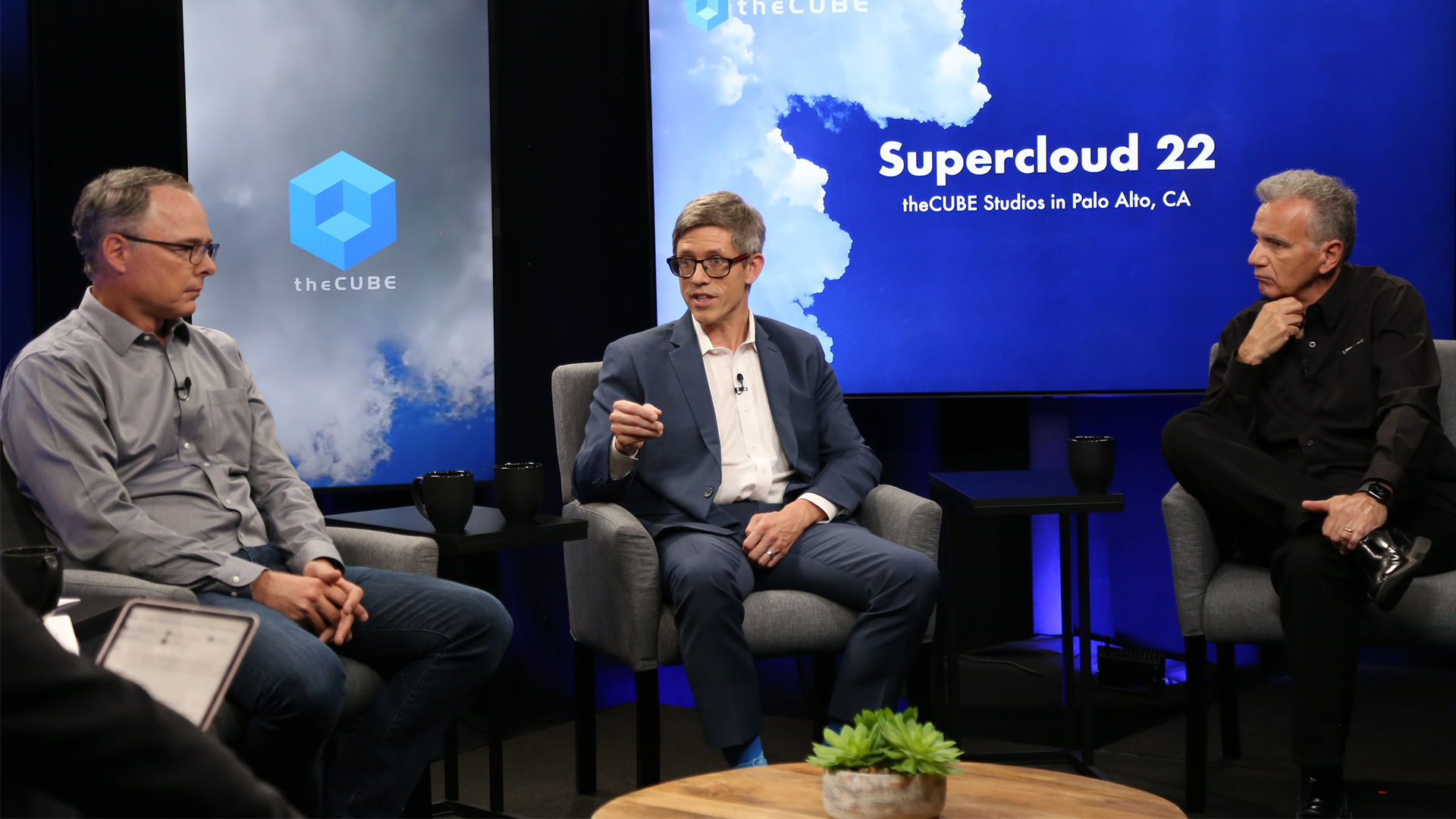 CLOUD
CLOUD
 CLOUD
CLOUD
 CLOUD
CLOUD
As theCUBE hosted the Supercloud 22 event Aug. 9 in its Palo Alto studios, the focus was on an idea that has been generating a lot of buzz as a potential solution for the disorganized multicloud environments encountered in most of today’s digital companies.
That would be the building of an abstraction layer that resides above and across hyperscale infrastructure, connecting cloud, on-premises workloads, and eventually stretching to the edge. The idea is to give developers and users a consistent experience without having to worry about what’s happening under the hood.
TheCUBE’s analysts identified this trend and gave it a name: supercloud. But is the concept of supercloud real or just hype?
“Look at the roster of companies that are presenting or participating today,” said Vittorio Viarengo (pictured, right), vice president of Cross-Cloud services at VMware Inc. “These are all companies that have some sort of multicloud, cross-cloud, supercloud play. They’re either public, have real revenue, or are about to go public. So the answer to the question is yeah, it’s real.”
Viarengo joined David McJannet (left), chief executive officer of HashiCorp Inc., and Will LaForest (center), field chief technology officer of Confluent Inc., for a fireside chat with theCUBE industry analysts John Furrier and Dave Vellante at Supercloud 22, during an exclusive broadcast on theCUBE, SiliconANGLE Media’s livestreaming studio. They discussed how to define supercloud, the potential benefits and blockers of adoption of the technology, and whether supercloud could become a widely adopted concept.
Around three-quarters of all companies are currently operating with multiclouds and multivendors, according to VMware statistics. This accidental multicloud status quo is creating inconsistency and complexity, driving up cloud costs, opening security risks, and forcing companies to look for new employees with specialized cloud development skills (and there aren’t many around). It’s cloud out of control.
“Cloud V1 is the very tactical, let’s go build something on cloud. Cloud V2 is like, ‘Whoa! Whoa! Whoa! Whoa!” McJannet said, describing the overwhelming experience of trying to manage workloads across multiple clouds without any operational consistency. Sorting out multicloud is a problem that requires architectural systems thinking, with companies having to step back and consider how to coordinate cloud at scale.
And the solution many are coming up with is supercloud.
“I’m going to be honest, we don’t think about supercloud,” said LaForest, who views the idea as an evolution of software as a service to abstract for developers as well as the user.
Seven years ago, if a company was producing a product for an end user or business user, it would be SaaS, but products for developers were built on an open-source or self-managed model, LaForest explained. But not all developers want to deal with the infrastructure; in fact, most of them just want to consume cloud-native services.
“With the success of a lot of the companies that are here today … it’s obvious that SaaS is the way to deliver software to the developers as well,” he said.
Because cloud-native services used by developers, such as Kafka and Terraform, are provided across multiple clouds, they have a unifying data layer. “When you move from the business user and the personal consumer to the developer, you can no longer be on a [single] cloud, there has to be locality to where applications are being developed,” LaForest said.
Viarengo equated building a supercloud abstraction layer to creating utility infrastructure in the physical world. “I open up the faucet. Is there water coming out? Yeah,” he said. “I don’t care how it got here. I don’t want to care.”
HashiCorp also has a pragmatic idea of what supercloud is. Rather than a single platform that runs everywhere, McJannet sees supercloud as building on the basic components of infrastructure, such as security, networking, databases, middleware and message queuing, to standardize operationally at each layer.
“Our view is that if the steady state of the world is multicloud, what you’ve seen is some modicum of standardization across those different elements,” he said. “There is sort of a layer-by-layer de facto standardization for the lingua franca.”
Supercloud is a way for operations and security to build guardrails for developers and prevent them from running so fast that the rest of the company gets left behind, according to Viarengo, who also discussed the concept with Vellante during the Supercloud 22 opening keynote.
Operations is wrestling with more complex problems than developers, according to McJannet, who agrees that a solution is needed to the problem.
“To build the app is not that complicated; for the ops person to let it see traffic is another thing altogether,” he said. “The breakpoint for so much of what looks easy to a developer is the operational reality of how you do that.”
The bottom line is that multicloud is a problem that’s causing headaches for business as well as information technology departments. Companies want to integrate their data and their products across multiple clouds, and not being able to do that impedes innovation, according to McJannet, who views the ability to instrument across clouds at every layer as a solution.
“It’s hard to do, but … if it does happen at every single layer, then voila, we organically have something that amounts to supercloud,” he said.
Will supercloud be a thing five years from now? It all depends on the customer, according to LaForest.
“We want to help our customers work with their data in real time regardless of where they are on-prem or in the cloud,” he said. “If supercloud can enable them to build applications that do that more effectively, that’s great for us.”
Here’s the complete video fireside chat, part of SiliconANGLE’s and theCUBE’s coverage of the Supercloud 22 event.
THANK YOU